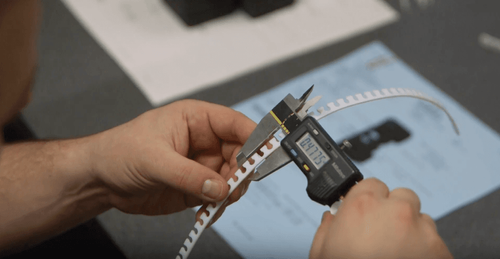
Save Time and Money on Custom Gaskets by Optimizing Tolerance
Determining the tolerance range is a key step in completing your custom gasket order. By defining the tolerance of your custom-cut flexible material, you’re establishing how much the die cuts can stray from the base measurement – without affecting fit and performance. But an expensive mistake product designers and engineers make is requesting a tighter than necessary tolerance range.
The following guide will help you avoid this mistake.
The hidden cost of overly tight tolerance ranges
At the design stage, it’s common for an engineer to indicate the tightest and narrowest tolerance range the material is capable of. They might make that call based on technical data provided by the material manufacturer. Occasionally, design software inserts this narrow range by default.
Choosing the tightest range can seem like the best route to a high-quality gasket that delivers the best possible performance. After all, you do want to make a great impression on your team.
But that level of control isn’t always needed. More often than not, you can relax the range with no effect on the quality and performance of the gasket. It’s always best to take a moment to find the range that meets the needs of the conditions and application. Making that determination depends on factors like gasketing materials, die-cutting method and the end use.
Bottom line, it’s not always critical to use the tightest tolerance on every custom gasket order. Doing so without considering other options can raise costs and delay delivery.
Outcomes from using too-tight tolerance ranges:
- Higher scrap rate of finished products that fall outside the tight range.
- Higher material costs to make up for rework and scrapped products.
- More frequent changeovers and stoppages for inspections, tooling adjustments and adding material.
Now that you know that defaulting to the narrowest possible tolerance range can add unnecessary costs to your finished product, it’s well worth the time to identify the best range for the project.
When you have an opportunity to get the best possible value from your gasket order and get something faster, why not take advantage of that and show the team what you accomplished?
How SRP helps you optimize gasket tolerance and performance
At SRP, we often recognize situations where the project manager or engineer identified a too-tight tolerance range. When we do, we’ll call it to our customer’s attention, and advise them to take a second look at calculating the best range for the material and application.
Custom projects call for a custom cut and a custom tolerance range. Taking the extra step to calculate a tolerance range that’s suitable for the project will make a big impact on costs and timeline. In a time when supply chain issues are delaying deliveries and increasing costs, taking this extra step can keep your costs in line.
Explore our materials and data sheets to identify the best components for your gasket. For guidance on the ideal tolerance range for your custom gasket, our specialists are just an email or phone call away.
